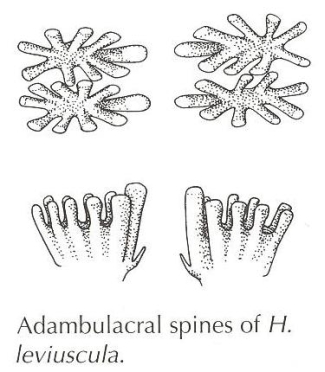Henricia leviuscula leviuscula is the most common red thin-armed sea star in the intertidal and shallow waters of British Columbia. The colour may vary from orange to brick-red, to brown, and some specimens may have a grey patch around the base of the arms or covering the disc. The aboral surface is variable, but the three rows of plates along the lower side of each arm are a constant feature. H.l. leviuscula has five arms (rarely six) up to 16 cm long, and an arm-to-disc ratio of 3 to 7. The aboral plates, covered with 30 to 60 small, close-set spinelets, are close together and normally larger than the papular spaces. The supero- and inferomarginals form a regular series. At the base of each arm, the two marginal series split to form a triangular group of intermarginals. The oral intermediates form a regular series to the arm tip, or nearly so. The adambulacrals bear 5 to 12 stubby spine lets in two transverse rows, increasing in size proximally, and a short, curved spine let deep in the furrow.
Small, yellowish sea stars that live under rocks in the intertidal zone and brood their eggs are probably an undescribed species of Henricia. Meg Strathmann of Friday Harbor Laboratories is working on the description and naming of this new animal.
Characteristics
